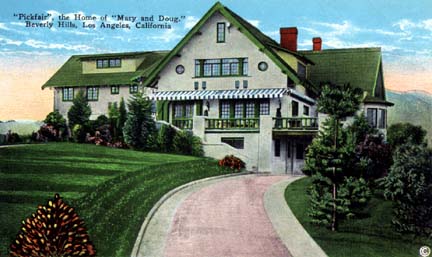|
These will be Golden Oldies from Maven's blogs so you all
won't have to traipse all over the internetscape!
Plus a new one about The Black Camel.
Grab the snacks and a cold drink--
AND DON'T FORGET YOUR STAKES AND HAMMER!
The Ultimate Vampire in a New Light
| Bela Lugosi in |
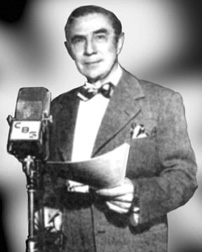
|
| Mystery House (194?) |
[This is a reprint of a post from
January 12,
2006, of The Old Movie Maven Blog that's she's
repeating since Maven found Gary D. Rhodes.
Gary has done a tremendous job of
profiling Bela Lugosi in the DVD called
Lugosi: Hollywood's Dracula.
Bela Lugosi was to be the star of Mystery House,
with Ken Carpenter as the host.]
Mystery House was a terrific radio series starring
Bela Lugosi, there was only one problem: It never aired. Fortunately, it survives on record and tape for
collectors to enjoy. The following excerpt is from an exhaustive book on Bela's career entitled Lugosi
by Gary Don Rhodes.
"Perhaps the most interesting
aspect of Lugosi's radio career is this -- an attempt at his own program [Mystery House]. It hoped to feature
Lugosi in the leading role of various 'Grand Guignol' tales. Ken Carpenter, a well-known radio personality at the time,
gave introductory and closing remarks. Among the planned episodes was a story about a woman who had been buried alive,
with producers hoping for Simone Simon as a guest. 'The Thirsty Death', a 'pilot' episode, survives and features John
Carradine and Lureen Tuttle as guests. Lugosi played a jealous husband who injects his wife or Carradine -- her presumed
lover -- with a poison, only to find out too late that the two were innocent of infidelity. This particular recording
is seemingly the only one actualy produced and recorded. The Mystery House press would have sponsered
it, so why the show never reached the air remains a question. The stories in Mystery House were to
be from the 'the greatest mystery theater the world has ever known, the Grand Guignol of Paris.' The only recorded show
claims Lugosi was to star in a series of film for Universal Studios. If produced, they would have echoed the Inner Sanctum
series of films Universal made with Lon Chaney, Jr. Some 14 episodes of Mystery House exist without Lugosi,
surviving artifacts from another of the program's incarnations."
What a loss to his many fans over the years.
Sigh.
Reprinted from January 12, 2006
<><><><><><><><><><><><><><><><><><><><><><><><><><><>
| Bela Lugosi |
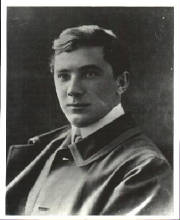
|
| as a Young Man |
Dracula
Who do you think of when someone mentions that name?
Miss Maven would bet that your first thought would be Bela Lugosi
from his 1931 break-through film of that name.
Did you know that there is a Spanish-language version with an
actor that many say could be . . . you should forgive Maven . . . a dead-ringer for Lugosi?!
Carlos Villarias was the star of the alternate version that
was filmed using the same sets as Lugosi's movie.
There are differences in their Draculas.
Bela Lugosi looks deadlier as Dracula because nobody would want
to think that anyone that handsome and suave could be anything but someone to take home and meet Mother.
That would solve all those mother-in-law jokes with a quick
"nip and tuck" anyway!
| Carlos Villarias |
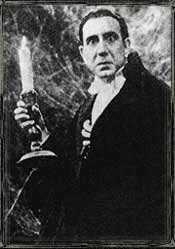
|
| A Lugosi Lookalike |
Carlos Villarias looks like he's
slightly touched in the head in
comparison.
Either that or somebody hacked
him off.
Who would be dumb enough to
face off against a vampire? . . . On
second thought . . . Miss
Maven
wouldn't put it past the Internal
Revenue Service!
Helen Chandler comes
off as plain vanilla compared
to Lupita Tovar, who has the
added advantage of sexier clothes.
Miss Maven warns you not to run out and get the Spanish version
because she's talking about sexier clothes for 1931!
| Dracula - The Spanish Version |
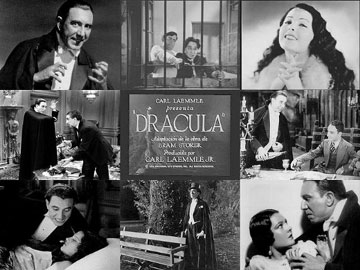
|
| With Carlos Villarias and Lupita Tovar |
| Dracula |
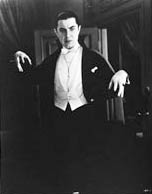
|
| On the Make |
Hah! You thought Miss Maven was getting
naughty, weren't you?!?!
~
~ ~
~ ~ ~
~ ~ ~ ~
~~~~~~
| Helen Chandler |
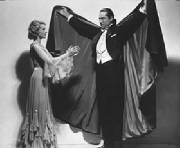
|
| Plain Vanilla? |
George Robinson was director George Melford's cinematographer.
He brought an entirely different feel to the sets, using
more mobile camera and more innovative use of angles and shadows than Karl Freund's camera work [on the Lugosi set].
Maven suspects that Freund's work on Dracula was
at the direction of Tod Browning since Maven thinks he did such superb work on such different works as The Mummy
(1932), Mad Love (1935), and television's I Love Lucy in the fifties.
And in what may be the ultimate vampire moment: When
Bela Lugosi enters Helen Chandler's bedroom and crosses over, Carl Freund tactfully fades the picture out.
| Dracula |
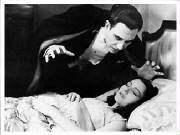
|
| With Salsa |
George Robinson's version shows Carlos Villarias' swooping
down to spread his cloak over Lupita Tovar as he's about to take a bite out of crime.
Or is it a "bite into crime" this time?!
Oh, dear, Miss Maven is getting a little too carried away
here.
Please excuse her while she tries to find the bourbon . .
. er, the smelling salts!
Reprinted from November 22, 2005
| Lon Chaney in |
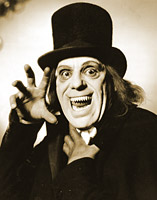
|
| London After Midnight (1927) |
LONDON AFTER MIDNIGHT
When is a vampire movie not a vampire movie?
When Tod Browning was involved.
He and Bela Lugosi went on to remake this movie in 1935 as Mark of the Vampire
with a cast headed by Lionel Barrymore and Jean Hersholt.
As to London after Midnight, ask Denis Gifford in A Pictorial History of Horror Movies (Hamlyn Publishing Group Limited, New York,
1973, pages 68-71):
British sensitivity changed the title of the new [Lon]
Chaney and [Tod] Browning venture: London After Midnight (1927) became The Hypnotist in England.
It was the first true American vampire movie despite the twist in its tail. Authenic vampire trappings abounded:
twin punctures in the jugular, a hickory stick staked through the heart, pallid and dark-eyed lovelies at the window.
Before the Browning version, Hollywood vampires had been pallid and dark-eyed lovelies of the Theda Bara breed: sucking
their men dry but not of blood. Chaney had his expected unmasking scene, but in reverse . . . The hideous vampire
. . . revealed as upright Inspector Burke of Scotland Yard, horn-rims and all! Outside the requisites of plot
payoff, the make-up took a little longer: sharpened dentures made it painful for Chaney to speak, and wire hoops in
his eye-sockets were tightened before takes to bulge his eyes. The denouement was not, it appears, a cop-out.
Claimed Browing:
"Mystery stories are tricky, for if they are too gruesome
or horrible, if they exceed the average imagination by too much, the audience will laugh. London After Midnight
is an example of how to get people to accept ghosts and other supernatural spirits by letting them turnout to be the
machinations of a detective. Thereby the audience is not asked to believe the horrible impossible, but the horrible
possible, and plausibility increased, rather than lessened, the thrills and chills."
| Lon Chaney |
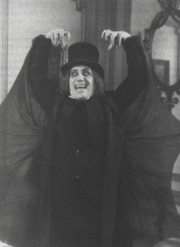
|
| Strikes a Pose |
Somebody forgot to tell James Whale when he made Frankenstein (1931),
The Old Dark House (1932), and The Invisible Man (1933)!
Not to mention Alfred Hitchcock and Stephen King as well!
Reprinted from January 16, 2006
The reason London After Midnight
is included on Bela Lugosi's page is that when Metro-Goldwyn-Mayer decided to do a talkie vampire movie, they went with Tod
Browning and Bela Lugosi.
This presented a problem since Browning and Lugosi had already done Dracula
some four years before.
So Hollywood did what Hollywood still does best. . . .
A remake!
Of London After Midnight.
OF COURSE!!!!!!!!
| The Young Dracula |
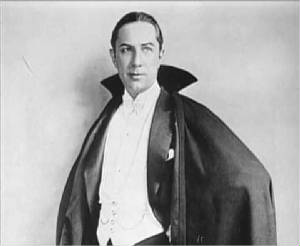
|
| Bela Lugosi |
"The blood is the life, Mr. Renfield."
These words have haunted us ever since
the first time that we heard Bela
Lugosi say them.
Why?
Dennis Gifford tries to explain it in A Pictorial History of Horror Movies (The Hamlyn Publishing
Group Limited, New York, 1973), page 82:
[That the 1931 Dracula is a] moody piece [is] due less to Browning than
his gifted cameraman, the favulous Karl Freund. Yet antique as Dracula undoubtedly is, it can still hold an
audience in thrall. That it is the oldest talkie still playing commercially is due entirely to the hypnotic performance
of the star.
"An evil expression in the eyes, a sinister arch to the brow
or a leer on my lips - all of which take long practice in
muscular control - are sufficient to hypnotize an audience
into seeing what I want them to see, and what I myself
see in the mind's eye."
Lugosi's hypnosis was helped out by Browning aiming twin pencil-spots into his eyeballs.
That one consistently missed its mark worried neither audience nor Warner Brothers, who quickly picked up the effect for John
barrymore's Svengali (1931). . . .
Maven personally wishes that Gifford had put it differently.
"Aiming twin pencil-spots into his eyeballs"
sounds awfully painful!
Maven would have made sure the guy doing it got his
own bloody pin-pricks in his . . . neck!
Reprinted from January 14, 2006
| Warner Oland, Dorothy Revier, and Bela Lugosi |
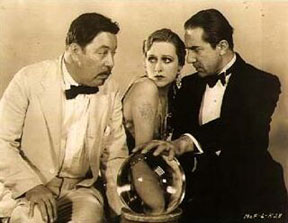
|
| The Black Camel (1931) |
YOU NEVER KNOW WHERE BELA LUGOSI
WILL TURN UP TO SCARE YOU!!
Bela Lugosi turned up in The Black Camel (1931), one of the Charlie
Chan movies that starred Warner Oland as the Chinese detective investigating
the murder of Shela Fayne
(Dorothy Revier).
Lugosi is the psychic she sends for from Hollywood,
just in time for him to become one of the
suspects in her murder.
The irony of this movie is that Lugosi was a Hungarian whose character came to
California from . . . London!
Oland was Swedish who came to live in Massacheusetts
as a child who grew up to play a Chinese policeman in Hawaii.
What are the odds of this happening OUTSIDE of Hollywood?
|
